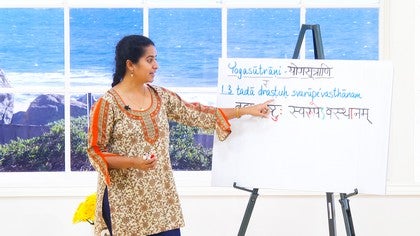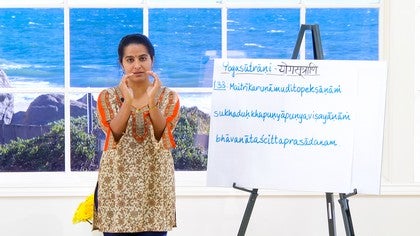Description
About This Video
Transcript
Read Full Transcript
Namaste dear friends, I hope you have enjoyed practicing the first sutra that we saw from the Yoga Sutras, the sutra number 1.2 which is the definition of Patanjali of what yoga is all about. It was a Yoga Shchitta Vrittini Rodha. So as you have said it and I hope you have been practicing with the writing of it, I hope you are beginning to enjoy this process of observing what exactly Sanskrit is doing to you. How is it engaging your being and making some little transformations that will help the study of Sanskrit make you a more richer person in some way or the other. In that same sequence, now let us look at the following sutra, the sutra number 1.3 which gives us the clue of what really happens when one is able to still the movements of the mind.
So that is the next one that we have, I will just explain this a little to you. So we have, means the seer. So the person who is able to quiet his mind starts seeing things. So off the seer, Swarupai, Swarupa means oneself, Rupa is the form, so the form of oneself and you would notice that there is a small kind of an apostrophe there. We will see what it corresponds to in the Sanskrit but it basically indicates that there is a combination of vowels that has happened there.
So we need to split it when we try to understand it. So it is Swarupai Avasthanam, Avasthanam comes from the root stha, stand to establish, they all have the same sounds. So Avasthanam is you become established in the form of yourself. Now let us see what this sutra looks like when you write it out. So I hope you are ready, let us go for it.
You saw that I wrote it this way but you can also write it this way if you want to go from left to right. In keeping with the fact that we are still learning how to combine our vowels with the consonants, I will mark the vowels in the red, the symbols of the vowels. And then we have Dhrash. So this Dhr has a combination of two consonants with a vowel. The vowel being the a, there won't be any extra symbol but the is the dental the.
Now the r that follows it will not look like the independent r. I will just mark it here for you for your own clarity. When you write it like that, that is the r. But when this combines with another consonant and follows another consonant, it changes its form quite significantly. And I just mark it in another color so that visually you can connect with it.
It becomes just that. We had seen it with the word Pranayama where it just became a slash, a forward slash at the bottom of the letter. So we have Dhruh and now we have a combination that you have seen earlier. It's the shhta. So do you remember the shhta brings in a doubt as to which shh should it be.
So we have the ter which is a cerebral ter and therefore the shh will have to be the cerebral shh and it's half of it. So this is what it becomes. Half of it. And then you add the ter or the half tomato to it. And then we have the vowel u which is a short vowel and that is represented by the small comma or like below.
So drashtu and we have the edge sound which is the visarga drashtuhu. And then we have swarupay. So the combination of swa is of s which is the dental s since there is no dot or accent there. So it's just the s which is the dental it's half. So that's the half.
The full would have had the stick, drop the stick and you have the s. Then you have the v which is represented like that because there is the simple vowel u there is no extra symbol to this. Then we have the letter r combined with u the long u. Now the letter r for some reason is quite special. So whenever you come across the letter r either in combination with a vowel or in combination with another consonant you just need to watch out a bit and yeah think a little more.
So we have the consonant r which is like that. We wrote it out there. And then you have the long u. So normally the long u would have been written like a letter below there. But because it is the r it sort of becomes a buckle and adds on there in the tail ru.
And then we have the per and the a that are combining. So you have the per which is written like that and you have the a which is represented by a single antenna on the head, swarupay. So we have swarupay. The next letter is this we have the small apostrophe there. That apostrophe is indicating to us like I mentioned swarupay avasthanam.
If you say that together it becomes swarupay wasthanam. And it is represented in a different manner. So the apostrophe there is normally becomes like a elongated s. It just indicates that this vowel will get a third length. So the vowel a already has two beats.
It's an aa and now when you add that extra thing it becomes of three beats. So you get aa swarupay. And then we have the v which is with the vowel a so it just stays without any extra symbol on it. Then we have the combination stha. That again is interesting because we see the appearance of the letter s.
Now when you say stha the letter that follows the s is a th which belongs to the dental category and therefore the s will have to belong to the dental group. So it is the half s that we have already seen with swarupay. So it's the half s and then we add the th which is the dental unvoiced with the breath. And then we have to add the aa which is the symbol that is there stha. And then we have the nam which is na since it's a vowel a nothing more and the m at the end.
The m at the end is the m and because it's half a sound there is no vowel after it. You have to add that mini backslash below it to make it just the phoneme um. So we have the word swarupayvastanam. I draw your attention to the fact that we don't draw the line all across the it's known as the avagra. And the th remember it was in between the teeth it was a dental letter and because the teeth have a gap it's the one with the breath.
So you have to leave that gap in the middle there okay. So thanam. So we'll just say that once tada drashtuhu swarupayvastanam. We'll try and read it in the transliteration tada drashtuhu swarupayvastanam. This is a good one to have chosen to share with you because you have the different teas in this particular sutra.
The first one is the dental one so it's a soft th again dental soft tada again soft drash and then now suddenly you have the dots below it. So the tongue has to go up swarupayva no dot so soft sthanam did you get that. Let's do it once looking at the devanagari tada drashtuhu swarupayvastanam. So continue your breath swarupayvastanam. Yes you have that I'll just break it up once and show you how it is combined here.
So I'll just do that part of it that way we don't repeat there too much. So swarupay. So you have swarupay plus avasthanam. Now since you are a beginner with Sanskrit you might be a little apprehensive about the fact that you know how do we know what sounds combined where and is there a consistency in the way these sounds combine. Now let me assure you that when it comes to sound combinations there are certain formulas there are certain rules and those rules follow the way that is or that permits an ease of pronunciation.
So if you say swarupayavastanam say that really fast swarupayavastanam swarupayavastanam swarupayavastanam swarupayavastanam. You will see that spontaneously the A will just lend in and therefore if you learn these basic euphonic combinations once then they will stay constant for all cases and that can be quite reassuring. So we do this swarupayavastanam becomes swarupayavastanam very good. So just to close the session I'd invite you to say this along with me say it in the transliteration once and then we'll say it in the devanagari by looking at the different symbols used to represent the sounds. We start.
Tada drashtuhu swarupayavastanam we'll do it in the devanagari tada drashtuhu swarupayavastanam. Keep practicing that's the only secret to success. There is no shortcut but if you stay with it if you allow these sounds to sink in you I can guarantee you that it will come to you. The beauty of Sanskrit is that the more you study it with a heart like a simple child the more this language which is also known as a mother will look after you. She will give herself to you so keep that openness as you study this.
Let not the complications of the mind and the fears of your being you know come in the way of the study. Go as far as you can whenever you can it's easy it will come. So astu punar mila maha, punar again mila maha meet so we'll meet again soon.







You need to be a subscriber to post a comment.
Please Log In or Create an Account to start your free trial.